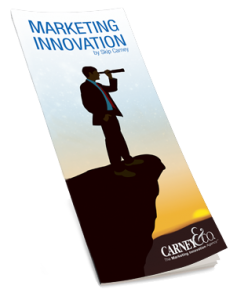Our Blog
Albert Einstein once said, “If at first the idea is not absurd, then there is no hope for it.” Steve Jobs took those words to heart. Every innovation he envisioned was at first considered absurd, undoable, and generally far-fetched.
Lesson One: If the idea is right and you know it, it doesn’t matter if everyone thinks it is absurd.
When he conceived the idea for The Apple Store, he took it to his board…all smart, successful people who had witnessed his magic first hand…the immediate response was ‘no way’. Gateway was closing stores left and right and no other computer manufacturer had been able to succeed at retail. The Apple Store is now the most successful retail concept in history. More sales per square foot, more sales per store, more profit, than any other retail store selling anything.
Lesson Two: He never took no for an answer.
iPod and iTunes revolutionized and saved the music industry. As brilliant and beautifully simple as the iPod was, it was just a music player with iTunes. And iTunes would be nothing without the consent of the music industry. One by one, Steve personally visited every major music publisher. One by one, he convinced them to give the iTunes model a try. He hoped to sell one million songs in six months. He sold one million in six days. Even in the light of that early success, there were holdouts. Most notably, the Beatles. He never gave up and in 2011, the Beatles joined iTunes.
Lesson Three: Never stop selling.
Steve Jobs was not just a genius, not just a visionary. There are many geniuses in the world who are unknown and have contributed little to our world. Jobs was different. He was a salesman. A Master Salesman. He believed in his product. He believed in its value. He believed he could help people if he could just help them understand. He kept working until they understood.
This, I believe is the real genius of Steve Jobs. He was smart enough to realize that all good ideas must be sold. And the best ideas have to be sold more.
What I’ve learned from Steve Jobs, so far…Never never never stop selling.
For more evidence that the creative well is running dry in this country, you need look no further than prime time TV. Seriously. And I’m not talking about the countless hours of mindless “reality” programming that have nothing to do with reality. Really. No, I refer to high quality shows that should know better. Two words…really and seriously. I defy you to find a single episode that doesn’t include one or both of these overused, unimaginative, rejoinders. The Closer, Last Man Standing, I even saw it used in a 2004 episode of Deadwood. Really. Apparently this downward spiral started right after Wild Bill Hickock was killed in 1876.
You’ve got to be kidding me? (aka Seriously?). No sh#@! (aka Really!). Somewhere along the way we lost cool, neat, darn straight, hell yeah, what the?, and peachy keen. And maybe we should have. But is really, seriously? the best you got? My college english professor once told me to never use “etc.”. He said it means you can’t think of anything else to say. I think of that a lot when I watch TV. Really. Seriously. It’s time for something new.
The trade show. The bane of every manufacturer’s existence. Exhibits, travel, expensive dinners, sales meetings, more expensive dinners. To go or not to go. What will the competition do this year? There are thousands of articles detailing the finer points of show business. This one asks just one question? Why do you go?
You can spend tens, even hundreds of thousands on the latest hardware, state-of-the-art technology, giveaways, and more but we submit that none of it will matter if you don’t know why you are there. A new client several years ago said they were getting ready for the “big” show. When asked why, the deer in the headlights answer was: “We always go to this show. Everybody (in our industry) goes to this show.” We said, “why not give your customers a reason to come by the booth and a reason to place orders during the show?” The result: They sold more product at that one show than in the previous 8 shows combined.
Before you go to the next show, make a plan. Sell product, hire reps, get some free press, introduce a new product, kick off a promotion…all of the above. Make it specific and make it measureable. When you get back home, assess your performance versus your goals. It will make the decision about next year’s show a lot easier.
Might even make it easier to order that last bottle of wine on the last night of the show.
You know the stories of the great innovators. Amazon, Apple, Google are the superstar innovation companies of the day. Their stocks, their sales, their margins, their profits, and their brands all reflect the benefits of innovation. But what happens if you DON’T innovate?
You wake up one day and you are closing 120 stores. You are Sears.
Sears used to be a great innovator. The mail order catalog. The money-back guarantee. The best tools on the planet. What have they innovated lately? They put blue shirts on their tires guys and called them The Blue Team. (For the record, that is NOT innovation.)
Sears stopped investing in innovation many years ago. Their competition didn’t. Today they are paying the price.
There’s an ad agency in Michigan that has adopted the tagline “Mutate or die!”. The owner (a friend of mine) reasons that the world is changing, his clients have to change too or they will be out of business.
The truth is, the world is changing because of the innovators. That is true today. It was true when the first cave man turned a rock into a wheel. It will always be true. Only innovating is innovating.
The answer to the question:
Innovate or become irrelevant.
Here’s a formula for creative thinking from Tom Monahan, former ad agency owner, Creative Director, heavy thinker, and consultant. Tom says that great ideas don’t come from creative people, they come from Creative Thinking. He outlines three steps to stimulate creative thinking and generate more ideas faster.
1. Ask a BETTER QUESTION….Don’t just ask the obvious questions, pose the “what if” and “why not” questions. What if this product didn’t exist? What if it were blue instead of green? Why not sell to women?
- Forces us to stretch
- Leaves a void and stimulates curiosity
- Visit the problem as early as possible so the subconscious mind can start to work sooner
- Write questions and answers. We remember more when we are
- writing, doodling, walking, etc.
2. Work FAST….100 MPH
- Go for lots of ideas FAST. Gets you through the obvious faster.
- Write them all down.
- Don’t start working on ANY of the ideas until you have ALL the ideas.
- Save ALL the ideas. Look at them 2 days later.
- Law of large numbers: If you have more ideas, you will have MORE IDEAS.
- Let go of what you think is brilliant…find something more brilliant
- Takes quantity to get to quality
- Don’t judge until you have LOTS OF IDEAS…
- Don’t be afraid of failure… people who succeed more fail more
3. 180 degree thinking.
- Think of how to do it “wrong”
- Do the opposite of conventional thinking
- Instead of a BIG idea, create a SMALL idea
- Disengages the rational mind
- Builds failure into the process


